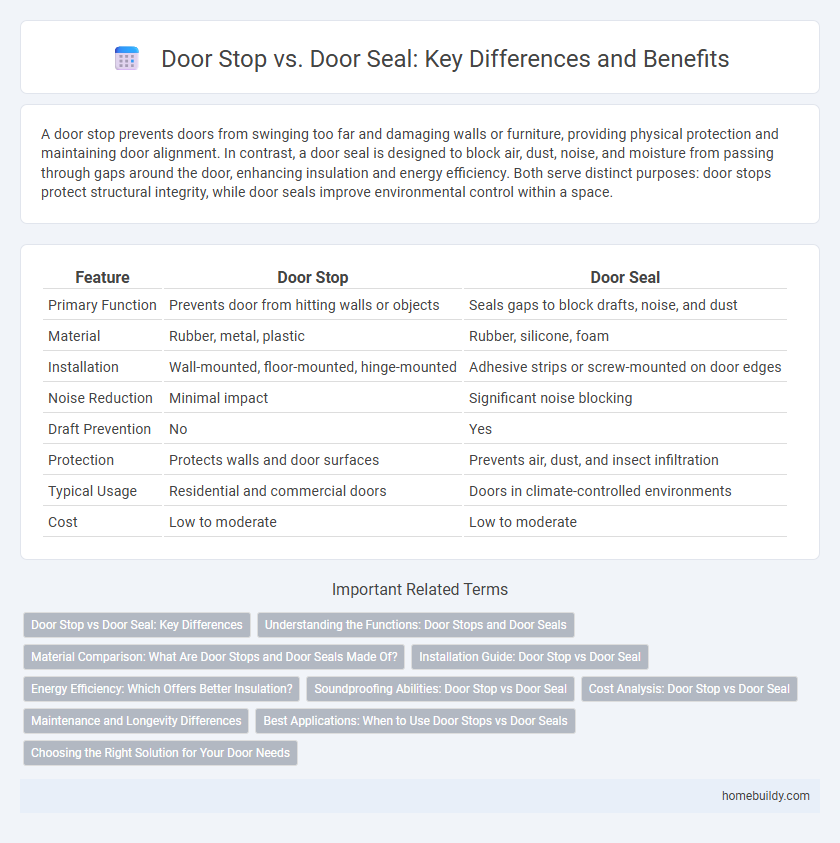A door stop prevents doors from swinging too far and damaging walls or furniture, providing physical protection and maintaining door alignment. In contrast, a door seal is designed to block air, dust, noise, and moisture from passing through gaps around the door, enhancing insulation and energy efficiency. Both serve distinct purposes: door stops protect structural integrity, while door seals improve environmental control within a space.
Table of Comparison
| Feature | Door Stop | Door Seal |
|---|---|---|
| Primary Function | Prevents door from hitting walls or objects | Seals gaps to block drafts, noise, and dust |
| Material | Rubber, metal, plastic | Rubber, silicone, foam |
| Installation | Wall-mounted, floor-mounted, hinge-mounted | Adhesive strips or screw-mounted on door edges |
| Noise Reduction | Minimal impact | Significant noise blocking |
| Draft Prevention | No | Yes |
| Protection | Protects walls and door surfaces | Prevents air, dust, and insect infiltration |
| Typical Usage | Residential and commercial doors | Doors in climate-controlled environments |
| Cost | Low to moderate | Low to moderate |
Door Stop vs Door Seal: Key Differences
Door stops are designed primarily to prevent doors from damaging walls or furniture by absorbing impact, whereas door seals focus on creating airtight and soundproof barriers to improve insulation and reduce noise. Door stops typically consist of rubber or metal components fixed at floor or wall level, while door seals use flexible strips or gaskets made from materials such as silicone or foam around door edges. Understanding these distinctions helps in selecting the appropriate solution for protecting surfaces versus enhancing energy efficiency and soundproofing.
Understanding the Functions: Door Stops and Door Seals
Door stops primarily prevent doors from swinging too far, protecting walls and furniture from damage, while door seals focus on creating airtight barriers to improve insulation and reduce noise. Effective door stops are essential for preventing structural damage caused by door impact, whereas door seals enhance energy efficiency by blocking drafts and dust. Both components play distinct yet complementary roles in maintaining door functionality and optimizing indoor comfort.
Material Comparison: What Are Door Stops and Door Seals Made Of?
Door stops are typically made from durable materials such as rubber, plastic, metal, or wood to effectively prevent door movement and protect walls. Door seals, on the other hand, are primarily composed of flexible materials like silicone, neoprene, foam, or vinyl that provide airtight and soundproof barriers. The choice of material reflects their distinct functions: door stops emphasize impact resistance while door seals focus on insulation and noise reduction.
Installation Guide: Door Stop vs Door Seal
Installing a door stop requires precise alignment at the door's edge to prevent slamming and ensure proper closure, typically involving screws or adhesive mounting on the frame or floor. In contrast, door seal installation focuses on creating an airtight barrier by fitting flexible strips or foam along the door's perimeter, often using adhesive backing or clips to enhance thermal insulation and soundproofing. Both installations demand careful measurement, but door seals prioritize continuous contact surfaces, whereas door stops emphasize impact absorption points.
Energy Efficiency: Which Offers Better Insulation?
Door stops primarily prevent door movement and protect walls but offer limited insulation against drafts and heat transfer. Door seals, designed with materials like rubber or silicone, provide a tight barrier that significantly reduces air leakage, enhancing energy efficiency by maintaining consistent indoor temperatures. For superior insulation and energy savings, door seals outperform door stops by effectively minimizing heat loss and improving thermal performance.
Soundproofing Abilities: Door Stop vs Door Seal
Door stops primarily prevent door movement and protect walls while offering minimal soundproofing benefits, as they do not create an airtight seal. Door seals, designed to fit tightly around door edges, significantly reduce noise transmission by blocking sound gaps and enhancing overall soundproofing performance. For effective soundproofing, door seals provide superior noise insulation compared to door stops.
Cost Analysis: Door Stop vs Door Seal
Door stops generally offer a lower initial cost compared to door seals, making them a budget-friendly option for preventing door damage and controlling movement. Door seals, while often more expensive upfront, provide superior insulation, noise reduction, and energy savings over time, potentially offsetting their higher purchase price. Evaluating the long-term benefits and maintenance expenses reveals that door seals can deliver greater cost-efficiency in energy conservation and weatherproofing compared to standard door stops.
Maintenance and Longevity Differences
Door stops require minimal maintenance, primarily involving occasional cleaning and checking for secure installation to prevent wear and damage. Door seals demand regular inspection to ensure airtightness and replace deteriorated rubber or foam, which directly impacts their effectiveness and lifespan. The longevity of door stops typically exceeds that of door seals due to simpler materials and less exposure to environmental wear factors.
Best Applications: When to Use Door Stops vs Door Seals
Door stops are best suited for preventing doors from swinging too far and protecting walls from damage, ideal for areas with high foot traffic or frequent door usage. Door seals excel in enhancing insulation, noise reduction, and preventing drafts, making them perfect for exterior doors or rooms requiring controlled climate and soundproofing. Choosing between a door stop and door seal depends on whether the priority is physical protection and movement control or energy efficiency and environmental sealing.
Choosing the Right Solution for Your Door Needs
Door stops provide effective protection by preventing doors from damaging walls or furniture, while door seals focus on enhancing insulation and soundproofing by sealing gaps around the door frame. Choosing the right solution depends on your primary need: use a door stop for impact prevention and a door seal for energy efficiency and noise reduction. Assess door usage, environmental factors, and desired functionality to ensure optimal performance and longevity.
door stop vs door seal Infographic

 homebuildy.com
homebuildy.com